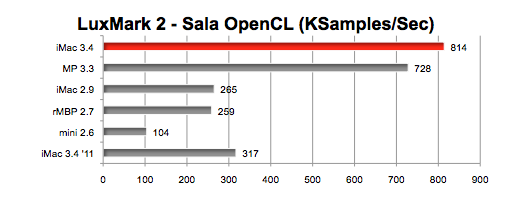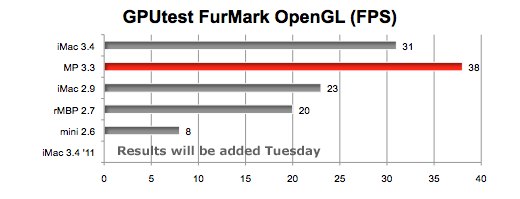Maxon's Cinebench 11.5 cross-platform benchmark uses code from Cinema 4D to stress all available cores of a CPU. Rather than time in seconds, it gives a speed rating. (HIGHER number rating is FASTER

The 6-core Mac Pro wins because it has more cores than the rest of the Macs. The iMac 2.9 i5 loses because it does not have Hyperthreading.
Geekbench 2.4 measures processor (integer and floating point speed) and memory (performance and bandwidth). It is multi-threaded and multi-core aware. The overall rating combines the four tests. We ran in 64 bit mode. (HIGHER number means FASTER.)

Again, the 6-core Mac Pro wins because it has more cores than the rest of the Macs. The iMac 2.9 i5 loses because it does not have Hyperthreading.
LuxRender's LuxMark 2 benchmarks OpenCL effects render speed. The test model used is Sala with 488,000 triangles. The results are measured in Thousands of Samples per Second. (HIGHER number means FASTER.

The newest, fastest iMac shines in this OpenCL test. That bodes well for users of pro apps that depend on OpenCL acceleration of certain visual effects.
Unigine Heaven 3 is a cross-platform benchmark that 'flies' through 26 scenes to measure DirectX or OpenGL performance. We ran the default setting at 1440x900 resolution. (HIGHER number in Frames per Second is FASTER)

The newest, fastest iMac shines in this OpenGL test.
Geeks3D has a free benchmark download call GpuTest containing three tests. FurMark is a very intensive OpenGL test that uses fur rendering algorithms to measure the performance of the graphics card. Fur rendering is especially adapted to overheat the GPU and that's why FurMark is also a perfect stability and stress test tool (also called GPU burner) for the graphics card. We ran at default settings at 2560x1440 (except in the case of the iMac 2.9 i5 which was forced to run at 1920x1080). HIGHER number in Frames per Second is FASTER.

We also ran GiMark which renders 100,000 instances of a mesh sphere made up of 128 triangles. We ran at default settings at 2560x1440 (except in the case of the iMac 2.9 i5 which was forced to run at 1920x1080). HIGHER number in Frames per Second is FASTER.

INSIGHTS
The newest, fastest CTO iMac, the 'late 2012' 3.4GHz Quad-Core i7 (Ivy Bridge) with the NVIDA GeForce TX 680MX, performs strongly in all tests. It was second only to the 6-core Mac Pro in the CPU tests (Cinebench and GeekBench) and beat all the other Macs in three out of four GPU tests, coming in second in the fourth GPU test.
An 8-core or 12-core Mac Pro with an 'alternative' GPU like the GeForce GTX 580 or Radeon HD 7970 might beat the newest, fastest iMac but you will spend a lot more money to get there. A lot more. Then again, if you own a fast Mac Pro already, maybe all you need is a faster GPU, more memory, and a screaming SSD boot drive.
MORE TO COME
As stated at the beginning, this is just a snapshot of performance. We've already run tests on the newest, fastest iMac using Aperture, Final Cut Pro X, Motion, Photoshop, Premiere Pro, After Effects, PhotoZoom, and more. We will post those results tomorrow. We haven't forgotten you hard-core gamers. Though Heaven is a good predictor of game performance, we've run tests with World of Warcraft (Pandaria), Dirt 2, X-Plane 10, Portal 2. These all run under OS X. Suggestions are welcome, especially if you can offer useful benchmarking methods. At some point we'll install Windows 7 or 8 on a Boot Camp partition to road tests some of the games and apps not available under OS X.
Since we provided the links to the above benchmarks, you can run the same tests on your current Mac. We'd like to see your results so we can build a database for past and present models of Mac. If you need more details on our test procedure, contact us.
Thoughts? Questions? Contact
Also, you can follow him on Twitter @barefeats